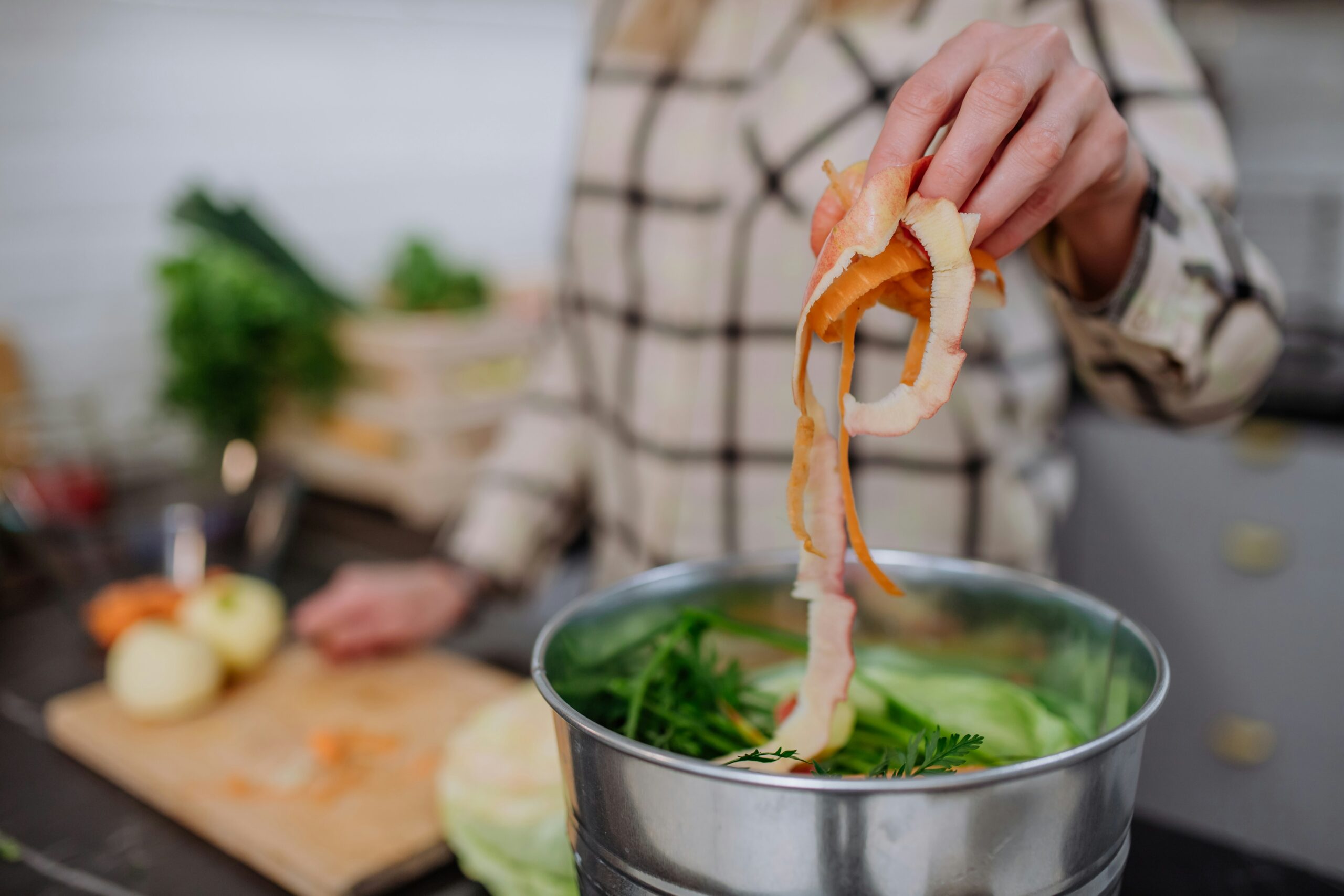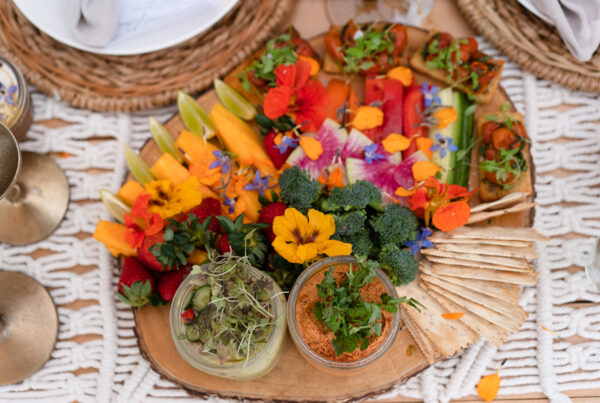Zero Waste Kitchen Hacks
As chefs, we’re always looking for ways to maximize flavor, minimize waste, and create an experience that’s as nourishing for the planet as it is for our guests. Whether you’re cooking in a professional kitchen, catering a retreat, or preparing meals for your family, cutting down on food waste isn’t just about saving money—it’s about honoring the ingredients, supporting sustainability, and getting creative in the kitchen.
For many of us, zero waste starts with how we shop, like bringing reusable bags, buying unwrapped produce, or bringing containers for bulk spices. But what about the actual food waste? The carrot tops, herb stems, citrus peels, and veggie scraps that often go straight to the compost? What if we could put them to use before they ever hit the bin?
Let’s talk about zero waste kitchen hacks—from regrowing your own herbs and veggies to choosing sustainable kitchen equipment to eco-friendly cleaning solutions.
Sustainable Food Sourcing: How to Buy Smarter and Support Local Agriculture
Reducing waste in the kitchen starts long before the cooking process—it begins with where and how we source our ingredients. Sustainable food sourcing is about making thoughtful choices that minimize environmental impact, support local economies, and ensure access to high-quality, nutrient-dense food. Whether you’re a private chef planning menus or a home cook shopping for your family, here’s how to make sustainable sourcing a priority.
- Buy from local farms and markets – Supporting small-scale growers keeps money in the community while reducing the environmental impact of long-haul food transportation.
- Shop bulk whenever possible – Bring reusable containers for grains, nuts, spices, and dried goods to cut down on plastic waste and save money.
- Plan meals around seasonal produce – Seasonal ingredients require fewer resources to grow, taste better, and align with nature’s cycles.
- Choose ethical meat, seafood, and dairy – Look for pasture-raised, grass-fed, or sustainably sourced options from trusted local suppliers.
- Forage or grow your own – Even a small herb garden or countertop sprouts can reduce the need for store-bought items while adding fresh flavors to meals.
By making intentional choices at the source, chefs and home cooks alike can practice zero waste kitchen hacks like reducing waste, creating more sustainable kitchens, and supporting better food systems.
How to Regrow Herbs & Vegetables from Kitchen Scraps
One of the easiest ways to reduce waste and save money is by regrowing ingredients from scraps. As chefs, having fresh herbs readily available is essential, and propagation ensures a steady supply without frequent trips to the store.
How to Propagate Fresh Herbs
Many herbs can be regrown from simple cuttings. Follow these steps:
- Snip a 4-6 inch sprig from basil, mint, rosemary, sage, thyme, or lavender.
- Remove the leaves from the lower half of the stem.
- Place the stem in a glass of room-temperature water in a sunny spot.
- Change the water every few days to keep it fresh.
- Once roots appear, usually within one to two weeks, plant the cutting in soil and allow it to flourish.
Chef’s Tip: Keeping a fresh herb garden enhances flavors and adds vibrant garnishes to dishes. It also serves as a thoughtful touch when catering an event or preparing private dinners.
How to Regrow Vegetables from Scraps
Many vegetables can be regrown with minimal effort, providing a sustainable and cost-effective way to maintain fresh ingredients:
- Green Onions & Leeks – Place the bulbs in a cup of water, and they will begin regrowing within days.
- Celery & Romaine Lettuce – Save the base, place it in water, and transplant it into soil once new leaves appear.
- Pineapple – Cut off the top, remove the lower leaves, and let it sit in water until roots form.
Instead of discarding these scraps, take advantage of their ability to regrow and maintain a supply of fresh ingredients at no extra cost.
Zero Waste Equipment: How Chefs Can Cut Disposable Waste
Cooking isn’t just about ingredients—it’s also about the tools we rely on in the kitchen. Reducing waste starts with choosing durable, reusable alternatives instead of single-use items that quickly end up in the trash. Whether you’re meal prepping, storing leftovers, or serving clients, investing in the right equipment can be an easy zero waste kitchen hack, significantly cut down on waste while maintaining efficiency.
Replace Single-Use Storage with Reusable Options
Many kitchens rely on plastic wrap, foil, and disposable containers for food storage, but there are long-lasting, reusable alternatives that work just as well, if not better.
- Glass or other storage containers with sealable lids – A durable, alternative to disposable. Higher quality reusable storage containers are also more hardy and leak less.
- Silicone food bags – A sturdy, washable substitute for plastic Ziploc bags, perfect for marinating, freezing, or storing small ingredients.
- Beeswax wraps – A sustainable option for covering bowls and wrapping leftovers instead of using plastic wrap.
- Stainless steel bento boxes – Ideal for meal prep without relying on plastic takeaway containers.
- Stackable stainless steel mixing bowls with lids – Reduce the need for plastic wrap when storing prepped ingredients.
Cut Down on Disposable Kitchen Tools
Some tools in the kitchen are designed for single use, but replacing them with higher-quality, reusable options helps reduce waste over time.
- Cloth napkins instead of paper napkins – Easily washable and much more sustainable for everyday use.
- Reusable silicone baking mats instead of parchment paper – These non-stick mats last for years and eliminate the need for disposable parchment or aluminum foil.
- Metal straws or glass straws instead of plastic – A simple switch that reduces waste, especially in beverage service.
- Wooden, silicon, or metal cooking utensils instead of plastic – More durable and won’t leach chemicals when exposed to heat.
- Stainless steel coffee filters instead of paper filters – A zero-waste option for brewing coffee that eliminates the need for single-use filters.
Choose Sustainable Cleaning & Packaging Supplies
For chefs who cater events or prepare takeaway meals, disposables may be unavoidable at times, but there are better alternatives to traditional plastic and styrofoam.
- Compostable plates, utensils, and napkins – Made from bamboo, sugarcane, or palm leaf, these break down naturally instead of lingering in landfills.
- Glass spray bottles for cleaning solutions – Instead of buying multiple plastic bottles of kitchen cleaner, refill glass bottles with concentrated solutions or make your own natural cleaners with vinegar and citrus peels.
- Dishcloths instead of paper towels – A reusable, compostable option that absorbs spills and dries quickly.
- Refillable hand soap and dish soap dispensers – Cut down on plastic waste by refilling rather than repurchasing bottled soaps.
Creative Ways to Reuse Food Scraps in Cooking
Great chefs don’t just follow recipes—they adapt, experiment, and find ways to make the most of every ingredient. Cooking with a zero-waste mindset is about seeing scraps not as waste, but as an opportunity to enhance flavor, reduce costs, and create something truly unique. Here are some practical and creative ways to transform food scraps into something delicious.
Make Homemade Veggie Stock
Vegetable scraps are packed with flavor, making them perfect for a rich, homemade stock. Save onion skins, carrot tops, celery ends, herb stems, and mushroom trimmings in a freezer-safe bag until you have enough. When ready, simmer them in water with garlic, bay leaves, and peppercorns for an hour or two. Strain and store the broth in jars or ice cube trays for easy use in soups, risottos, and sauces.
Infuse Vinegars and Oils for Extra Flavor
Citrus peels, herb stems, and garlic scraps can turn everyday vinegar or oil into a gourmet ingredient. Simply add scraps to a jar, cover with vinegar or oil, and let it sit for at least a week. Strain and use the infusion in dressings, marinades, or finishing drizzles.
Turn Carrot Tops and Beet Greens into Something Tasty
Carrot tops and beet greens are often tossed, but they have just as much flavor and nutrition as the roots. Blend carrot greens into a fresh, herbaceous pesto or chop them into a salad. Beet greens can be sautéed with garlic and olive oil, added to soups, or even baked into crispy chips.
Repurpose Fruit Peels for Infusions, Snacks, and Desserts
Instead of tossing fruit peels, use them to add natural sweetness and depth to dishes:
- Apple peels can be tossed with cinnamon and baked into a crispy snack.
- Citrus peels make a great addition to infused vinegar, homemade cleaning solutions, spreads, or even limoncello.
- Banana peels can be blended into smoothies or boiled for a subtle, floral tea.
Give New Life to Stale Bread
Bread that’s past its prime is far from useless. Tear it up for homemade croutons, pulse it into breadcrumbs, or use it in a hearty panzanella salad. If the bread is too hard to eat, soak it in milk or broth to make bread pudding, stuffing, or even dumplings.
Chef’s Tip: Many high-end restaurants are embracing zero-waste cooking by turning food scraps into broths, ferments, and unique garnishes. Clients appreciate a chef who can craft a flavorful meal while minimizing waste—sustainability isn’t just good for the planet, it’s a selling point.
Low-Waste Cleaning: Sustainable Solutions for a Greener Kitchen
Kitchens generate a significant amount of waste, and cleaning supplies are a major contributor. Between single-use paper towels, plastic spray bottles, and chemical-heavy disinfectants, the waste can add up quickly. A few simple swaps can make a big difference in creating a more sustainable, low-impact cleaning routine—without sacrificing efficiency or sanitation.
Switch to Refillable Cleaning Products
Most commercial cleaning products come in single-use plastic bottles, but many brands now offer concentrates and refill stations to reduce waste. Instead of buying a new bottle each time, opt for glass or durable plastic spray bottles that can be refilled with concentrated cleaners or homemade solutions.
- Blueland, Branch Basics, or Mrs. Meyer’s Concentrates – These brands offer plant-based, refillable cleaning solutions that cut down on unnecessary packaging.
- DIY All-Purpose Cleaner – A simple mix of vinegar, water, and citrus peels creates a powerful, natural disinfectant without artificial chemicals. Add essential oils like lemon or tea tree for extra antibacterial properties.
- Castile soap as a multi-use cleaner – Dilute it for dish soap, hand soap, or an all-purpose spray, reducing the need for multiple cleaning products.
Ditch Disposable Paper Towels & Sponges
Single-use paper towels and synthetic sponges contribute to unnecessary waste and microplastic pollution. Instead, switch to reusable, compostable alternatives that last longer and work just as well.
- Dishcloths – Made from plant-based materials, they absorb spills like paper towels but can be washed and reused for months.
- Unpaper towels – Cloth napkins or reusable “paper towels” can be washed and used again.
- High quality sponges and scrub brushes – Choose options made from natural fibers like loofah, coconut husk, or bamboo instead of synthetic sponges that release microplastics into the water.
Sustainable Dishwashing & Kitchen Cleanup
There are so many options now for refillable options for cleaners, which are simple and effective zero waste kitchen hacks…
- Refillable dish soap dispensers – Instead of buying new plastic bottles, purchase dish soap in bulk or use refillable stations.
- Solid dish soap bars – A concentrated, plastic-free alternative that lasts longer than liquid soap.
- Bamboo dish brushes – Replace plastic scrubbers with durable bamboo brushes with compostable bristles.
Reduce Plastic Waste in Trash & Recycling
Even when disposing of unavoidable waste, there are ways to minimize environmental impact:
- Compost food scraps instead of sending them to landfills. (Or feed them to your chickens!)
- Use biodegradable trash bags instead of traditional plastic bags.
- Recycle properly by rinsing out containers before disposal to prevent contamination in recycling bins.
- Choose products that have less packaging and/or are recyclable locally.
By making these simple swaps, chefs can create a cleaner, greener kitchen without extra effort. Sustainability isn’t just about food—it’s about how we maintain our spaces with less waste, fewer chemicals, and smarter choices.
Zero Waste Kitchen Q&A: Your Questions Answered
Looking for practical ways to reduce waste in the kitchen? Here’s a quick recap of the best zero waste kitchen hacks, organized in a question-and-answer format to help you find exactly what you need.
How can I reduce food waste in my kitchen?
The key to reducing food waste is using every part of an ingredient before throwing anything away. Save vegetable scraps for homemade stock, use citrus peels to infuse vinegar or oils, and repurpose stale bread into croutons or breadcrumbs. Planning meals carefully and storing food properly also prevents unnecessary waste.
What are some creative ways to reuse food scraps?
There are plenty of ways to get creative with food scraps:
- Make vegetable stock with leftover onion skins, carrot tops, and herb stems.
Turn fruit peels into snacks by drying apple peels with cinnamon or candying citrus peels. - Infuse oils and vinegars with herb stems, garlic skins, or citrus rinds.
- Use stale bread for breadcrumbs, stuffing, or panzanella salad.
- Blend carrot tops or beet greens into pesto instead of discarding them.
Which vegetables and herbs can I regrow from scraps?
Many kitchen scraps can be regrown into fresh produce with minimal effort. Some of the easiest options include:
- Green onions and leeks – Place the bulbs in water and they’ll regrow within days.
- Celery and romaine lettuce – Save the base, place it in water, and transplant it once new leaves appear.
- Herbs like basil, mint, rosemary, and thyme – Propagate fresh sprigs in water until roots form, then plant in soil.
- Pineapple tops – Remove lower leaves, set in water until roots form, then transfer to a pot.
How can chefs reduce disposable waste in the kitchen?
Switching to reusable kitchen equipment is the best way to cut back on waste. Some simple swaps include:
- Glass storage containers instead of plastic Tupperware.
- Silicone food bags instead of disposable plastic bags.
- Beeswax wraps instead of plastic wrap.
- Reusable cloth napkins instead of paper napkins.
- Stainless steel or bamboo utensils instead of single-use plastic.
- Silicone baking mats instead of parchment paper.
What are the best zero-waste cleaning products for a kitchen?
Many conventional cleaning products come in plastic bottles and contain harsh chemicals. Instead, opt for:
- Refillable cleaning concentrates from brands like Blueland, Branch Basics, or Mrs. Meyer’s.
- DIY all-purpose cleaner made from vinegar, water, and citrus peels.
- Dishcloths or reusable towels instead of paper towels.
- Sponges and scrub brushes made from natural fibers.
How can I store food without using plastic?
To keep food fresh without relying on single-use plastic, consider these alternatives:
- Beeswax wraps for covering bowls or wrapping cut produce.
- Glass jars for storing dry goods, sauces, or leftovers.
- Silicone stretch lids to replace plastic wrap.
- Vacuum-sealed glass or stainless steel containers for meal prepping.
How can private chefs offer a more sustainable experience for clients?
Chefs can reduce waste while maintaining high-quality service by:
- Planning portion sizes carefully to avoid excess food waste.
- Using sustainable packaging like compostable containers for take-home meals.
- Offering a reusable container program for repeat clients.
- Using refillable and non-toxic cleaning supplies when working in client homes.
- Highlighting zero waste practices as part of their culinary brand.
Bringing Zero Waste Into Your Kitchen: A Smart, Sustainable Investment
Embracing a zero waste kitchen isn’t just about reducing environmental impact—it’s also a smart investment for chefs and home cooks alike. While switching to reusable equipment and sustainable ingredients may require an upfront cost, these choices pay off in the long run by cutting down on unnecessary spending, extending the life of ingredients, and creating a more efficient kitchen.
For private chefs and food professionals, zero waste cooking is also a marketable skill. Clients who prioritize sustainability, health, and conscious living are actively looking for chefs who align with their values. Whether catering retreats, offering farm-to-table dining, or preparing meals for eco-conscious households, incorporating low-waste practices can set you apart in a competitive industry.
Beyond financial and marketing benefits, zero waste cooking fosters a deeper connection to food. By using every part of an ingredient, regrowing herbs, and choosing sustainable tools, chefs not only create flavorful meals but also honor the work that goes into producing each ingredient.
Making these changes doesn’t happen overnight, but every small step—switching to refillable cleaning products, composting scraps, or swapping plastic wrap for beeswax wraps—adds up to a healthier, more sustainable kitchen.
Start where you can, experiment with new methods, and let sustainability become second nature in your culinary practice. Whether you’re cooking for yourself, your family, or your clients, reducing waste is a choice that benefits everyone.





